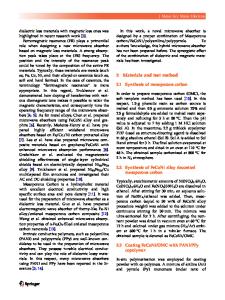Carbon in diesel participate matter: Structure, microwave absorption, and oxidation
- PDF / 370,075 Bytes
- 4 Pages / 584 x 793 pts Page_size
- 54 Downloads / 369 Views
The structural, microwave absorption, and oxidation characteristics of diesel particulate matter (DPM) collected from a CAT 3304 diesel engine are reported. The x-ray diffraction of DPM yields the characteristic peaks of pregraphitic carbons (cokes and^ pitches), and its modeling yields d(002) ~ 3.429 A and a crystallite size of about 20 A. The real and imaginary parts of the dielectric constant e = e' + ie" are measured at 8.7 GHz using the cavity perturbation technique. The measured values for the DPM are e' = 8.6 ± 1.7 and e" = 7.4 ± 1.5, compared to e1 = 1.0 and e" « 6 X 10~5 for the ceramic trap material used for collecting DPM. The oxidation products of the DPM, analyzed by FTIR spectroscopy, are found to contain CO 2 and CO with a peak yield occurring around 500 °C. Since microwave power absorption is proportional to e", these results show that selective microwave heating of the DPM in the ceramic traps should be a very efficient process with CO2 and CO as the main oxidation products.
The diesel particulate matter (DPM), a constituent of the diesel engine exhausts, is known to be a potential carcinogen. 13 Consequently, suitable methods to control/eliminate DPM have been under investigation in recent years. The DPM can be controlled by using fibrous ceramic traps. However, clogging of traps by DPM requires the impractical periodic trap replacement. Following the recent work by Garner and Dent,4-5 we are investigating the in situ use of microwaves to regenerate the ceramic traps, thereby eliminating the trap replacement step in this process. The use of microwaves instead of conventional heating for trap regeneration has the advantage of selective heating of the DPM instead of the trap, if the trap absorbs insignificant microwave power relative to the DPM. Also, the oxidation characteristics of the DPM are needed to understand fully this regeneration process. The rate of energy absorption P per unit volume of a sample is given by P = coe"\E0\2,
(1)
where co is the angular frequency, |£ 0 l 2 is the intensity of the microwave radiation, and e" is the imaginary part of the dielectric constant (e = e' + ie"). Thus measurements of e" for DPM and ceramic trap material are needed to determine their capacities for microwave absorption. In this paper, we report these measurements carried out at a frequency of 8.7 GHz. Following microwave absorption, the DPM is expected to oxidize. The oxidation characteristics of the DPM have been investigated using Fourier transform infrared (FTIR) spectroscopy of the evolved gases CO 2 and CO and using thermogravimetric analysis (TGA). Finally, J. Mater. Res., Vol. 10, No. 5, May 1995
some information on the structure of carbon in DPM has emerged from the analysis of its x-ray diffraction spectra. Results of these experiments are reported in the following pages. The DPM used in these experiments was collected from the exhaust of a CAT 3304 diesel engine by operating over a range of steady-state and transient duty cycles using the sampling procedure described elsewhere.6 The x-ra
Data Loading...











